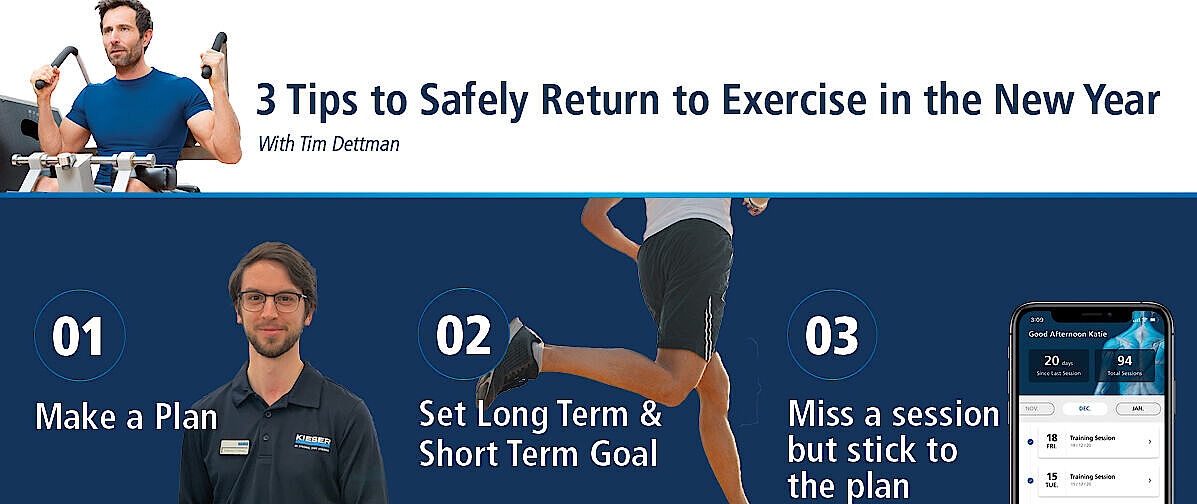A new year – A strong start.
3 tips to safely return to exercise in the new year
Author: Tim Dettmann, Kieser Physiotherapist, Runner, enthusiastic surfer and high handicap occasional golfer.
For some of us, exercise in 2020 was a write off. For some of us, we did more exercise than ever (I should admit here that in my own enthusiasm I may have overtrained my way to injury in 2020). Regardless of which group you fall into, we all overwhelmingly agree that ‘My health is more important in 2021 than ever’. So for everyone looking to get off to a strong start, here are 3 tips to make sure you get your year off to a strong, healthy and safe start.
Make a plan:
Work, home renovations and holidays are all examples of things that work better with a plan; exercise and health are no different. So before you enthusiastically start a 10km run or spend $100’s on new sporting equipment, sit down and make exercise your plan. Don’t be overwhelmed by making it too complex, but do understand that you need to:
- Do 2 strength training sessions per week - not on consecutive days.
- Do 150 minutes of moderate activity on the off days – this could be walking, tennis, golf or anything else you enjoy.
- Have 1 rest day per week
For example, my 2021 plan:
- 2 x Kieser sessions per week, 1 supervised Assisted Training and 1 by myself
- 1 x 30min swim with Bondi Salties every Friday morning
- 2 x 30 - 60min runs per week
- 2 x Surfs per week – hopefully more if weather permits
Set 2 goals: 1 for March and 1 for June
We could argue all day about whether short term or long term goals are more important, but the answer is that they both are – for different reasons. In January, short term goals are important so you build slowly and don’t overtrain – something we are all susceptible to! Long term goals are important so you continue to improve and don’t plateau – so the two work together to keep you training both effectively AND safely. Again, don’t get overwhelmed by how complex this can be, here are my personal examples as I return to exercise from injury:
March
1. Get back to running 10km, time doesn’t matter
2. Complete 100% of my Kieser sessions.
June
1. Run from North Bondi to Macquarie Lighthouse in under 45min
2. Get back to my training weight of 160lb on the Lumbar Extension at Kieser.
Miss a session but stick to the plan
Let me tell you a home truth: you are going to miss a session. AND, you are going to have a bad week. That’s life, it happens – take the whole of 2020 for example where we never knew what was happening the next day. So when you do miss a session you will have a choice to either a. Throw everything out the window or b. Be realistic and get back into a routine as soon as you can. Unless you are an elite athlete getting paid $800,000 per year to look after your health, it's unrealistic to think that you can never deviate from the plan (and even elite athletes miss a session or two). So when you do, don’t be disheartened, don’t fall off the bandwagon; if you have missed one Kieser session I promise you won’t have lost any strength at all, you can simply start again from where you left off.
I've long been an advocate of finding an exercise program that you complete for the long term and research confirms that, in those over 55 in particular, the duration of your training program (in weeks or months) has been shown to be the most important variable in predicting your strength gains. (Silva et al 2014).
These three tips might seem simple, and that’s (simply), because they are. Once you have read them once, discuss your plan, your goals and your compliance strategy with your Kieser Exercise Scientist, Exercise Physiologist or Physiotherapist so we can help you. Please don’t go on your health journey alone – our team all have University degrees in health and exercise science so we know a thing or two that can help. We’re here to tailor your exercise plan, to make the little changes required, and to answer any questions you have.
If you’ve got a specific question, tune in to Wil Nguyen’s webinar on ‘Back to Training’ on Wednesday, 20th January and ask Wil. Alternatively, email it to info@kieser.com.au and we’ll include another blog post next month.
References:
Influence of strength training variables on strength gains in adults over 55 years old: A meta-analysis of dose response relationships. Silva N, Oliveira R, Fleck S, Leon A, Farinatti A. (2013) Journal of Science and Medicine in Sport. 17, pg 337-344






























